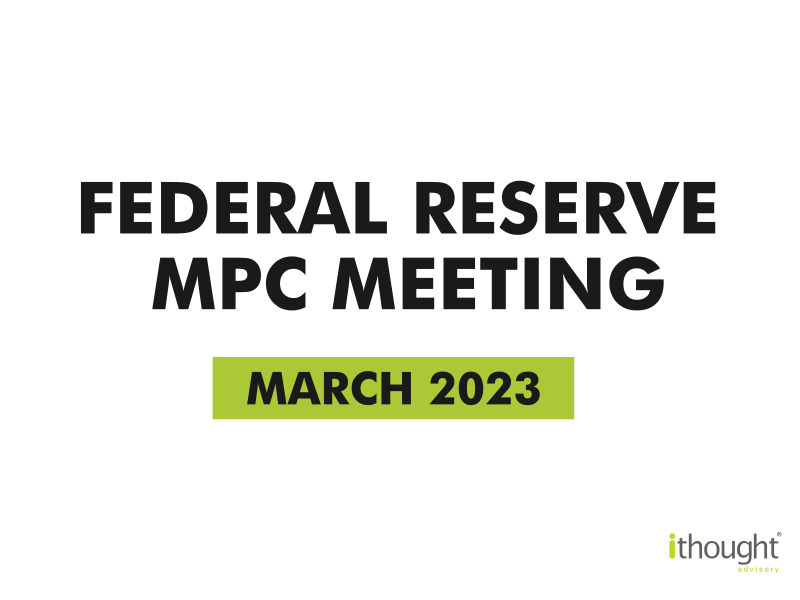
Background and Decision
All eyes were on the Federal Reserve this month as the markets intently anticipated their next move. The markets were spooked by the bank run on Silicon Valley Bank and this triggered a sell-off of smaller, regional banks in America. Amidst all this, in Europe, Credit Suisse had also failed and had to be bailed out by UBS, and the Swiss government. The European Central Bank raised rates by 50bps. In all this chaos, gold rose 8%.
So, what did the Fed do?
On the back of sticky inflation and a tight labour market, the board saw enough evidence to warrant another rate hike of 25 basis points. A pause in rates was considered, but data on inflation and labour markets were stronger than expected. The federal funds rate now stands at 4.75% to 5%. Rate cuts this year are not likely. The aim of the mandate is to bring down inflation to the 2% target, and price stability. Growth is expected to be subdued at 0.4% this year and 1.2% in 2024. Yet, employment rose by 351,000 jobs per month for the last three months. Unemployment for February was at 3.6%. Wage growth has eased a little, but still, labour demand exceeds supply.
Projections
The projected median unemployment rate at the end of 2023 stands at 4.5% and in 2024 stands at 4.6%. January’s Core PCE inflation stood at 4.7%, a long way away from the 2% target of the Fed. Projected total PCE for 2023 stands at 3.3%, 2.5% in 2024, and 2.1% in 2025. Chairman Powell indicated that it would take a long time to bring inflation back down to a comfortable level and that the journey would not be smooth.
Banking system events in the last two weeks are likely to affect system liquidity and in turn, economic outcomes. The extent of these effects is too soon to determine right now. The Federal Reserve states that monetary policy actions other than rate hikes may be more appropriate to control inflation, going forward. If events go as per the Fed’s projections, the appropriate federal funds rate (median opinion from the board) is set at 5.1% at the end of 2023, 4.3% at the end of 2024 and 3.1% at the end of 2025. This path is not set in stone. If the economy does not evolve as projected, then this will vary.
Banking System
The view of the Federal Reserve is that the US banking system is strong, and liquidity is strong. Deposit flows have stabilised over the last week. The Systemic Risk Exception (where the $250,000 ceiling is lifted) invoked for SVB and Signature Bank was done so due to the risk of contagion to other banks and the financial markets. Jerome Powell expressed his opinion that the Silicon Valley Bank’s management failed as they grew the bank too quickly, and exposed the bank to liquidity risk, and interest rate risk, without a hedge. These are not systemic weaknesses. Silicon Valley Bank was an outlier in terms of uninsured deposits, and duration risk. The Federal Reserve is working to find out what went wrong and will put up appropriate regulations and supervision based on its findings. With regard to liquidity support, the recent support offered to the system should not be construed as monetary policy. It is a temporary loan to banks given to support liquidity and bolster confidence in the banking system.
Conclusion
“There are costs in bringing inflation down to 2%, but the costs of failing are much higher”. In an environment where some thought that the Fed might take a pause, they have gone ahead and raised rates. The inflation and unemployment control mandate is clear now. An interesting point is that the Fed seems to suggest that further rate hikes, though not ruled out would take lesser precedence over other monetary tightening actions. Further investigations into the risk control failure in Silicon Valley Bank are being undertaken, the results of which would be made public on the 1st of May 2023.
Things To Look Out For
-
- RBI Monetary Policy Decision – April 2023
- Review of the supervision and regulation of Silicon Valley Bank – May 2023